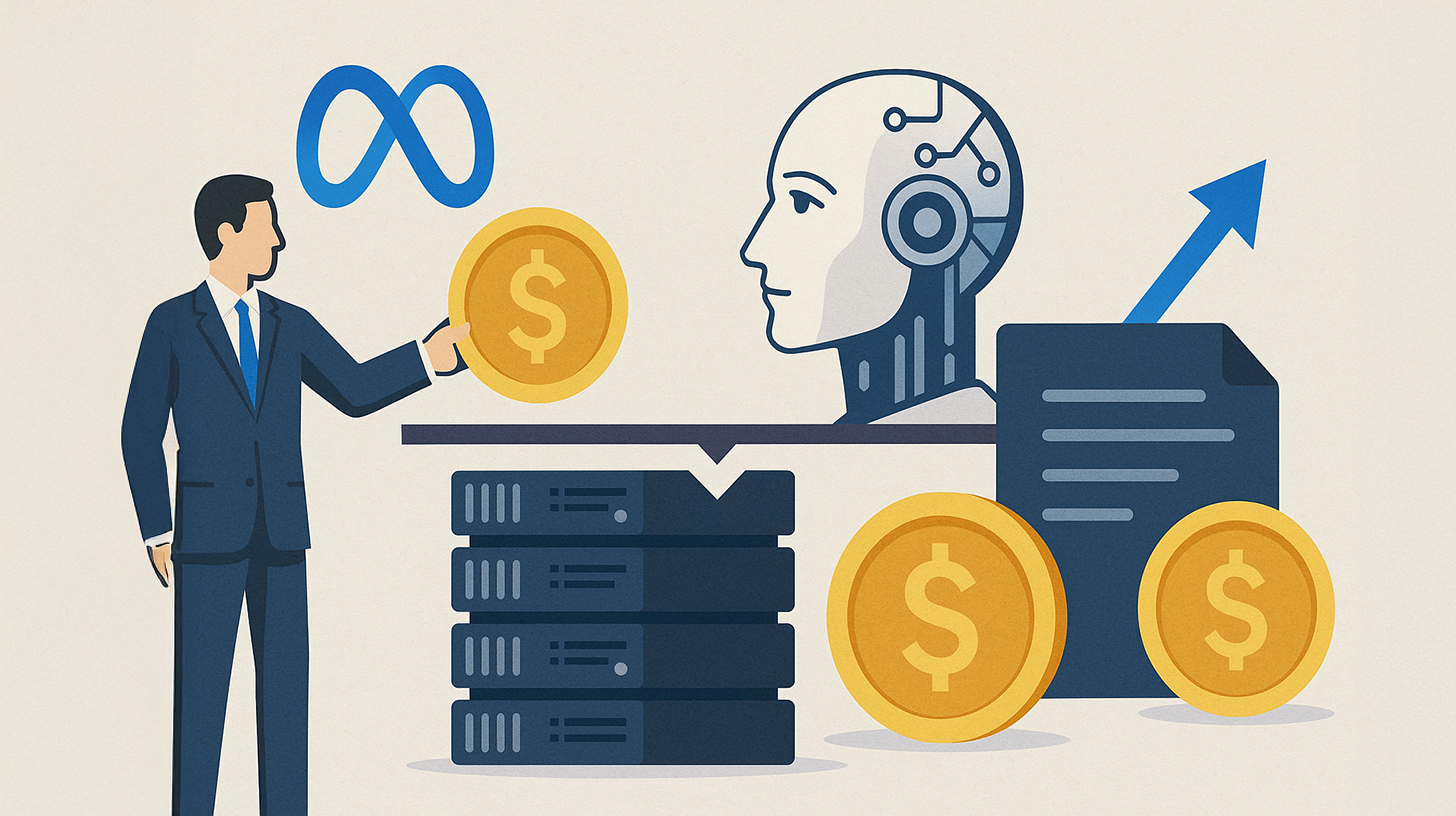Meta relies on partner financing for AI infrastructure: Billion-dollar deal for data centers
The strategic shift in AI infrastructure
Meta Platforms has made a significant strategic shift in the financing of its artificial intelligence infrastructure. The company is selling $2 billion worth of data center assets to seek external partners to finance its extensive AI development infrastructure. This decision reflects a fundamental shift among tech giants that have traditionally self-financed their expansion but are now faced with the rapidly rising costs of AI data centers.
The new strategy is evident in Meta's quarterly report, in which the company announced that it had already approved a plan to divest certain data center assets in June, reclassifying $2.04 billion in land and construction projects as "held for sale." These assets will be transferred to third parties within the next 12 months for joint data center development.
Suitable for:
Financing the AI revolution
Spending on AI infrastructure is reaching unprecedented levels. Meta has raised its capital expenditure forecast for 2025 to $66 billion to $72 billion, an increase of approximately $30 billion over the previous year. These massive investments are part of an industry-wide trend in which the four largest technology companies—Meta, Amazon, Alphabet, and Microsoft—will collectively spend up to $364 billion in their respective fiscal years 2025.
Susan Li, Meta's chief financial officer, confirmed in an analyst call that the company is actively exploring opportunities to collaborate with financial partners on joint data center development. These partnerships are intended to help finance the massive capital expenditures for the coming year. While Meta continues to plan to finance the majority of its capital expenditures internally, certain projects could attract "significant external financing" and provide more flexibility should infrastructure requirements change.
The superclusters of superintelligence
Mark Zuckerberg has unveiled ambitious plans for creating a "superintelligence" that will require hundreds of billions of dollars in investment in AI data centers. At the heart of this strategy are two groundbreaking projects called Prometheus and Hyperion, designed to deliver industrial-grade computing power through superclusters.
Prometheus, a one-gigawatt data center, is scheduled to go live in 2026, making it one of the first AI infrastructures of this scale. The center will be built in New Albany, Ohio, and is expected to have 500,000 graphics processors. Hyperion, the even more ambitious project, will be built in Louisiana and can scale up to five gigawatts over several years. Zuckerberg describes these facilities as so large that one would cover "a significant portion of the floor space of Manhattan."
The challenges of AI infrastructure
The development of these massive AI data centers presents significant technical and logistical challenges. The energy intensity of AI workloads far exceeds that of traditional data centers. According to research data from the International Energy Agency, data center power consumption will rise to 945 terawatt-hours by 2030, roughly equivalent to Japan's annual electricity consumption. AI workloads already account for 24 percent of server power consumption and 15 percent of total data center energy consumption.
Water scarcity poses another critical challenge. One of Meta's data centers in Newton County, Georgia, has already caused water shortages in some households. These environmental impacts are increasing the pressure on technology companies to find more sustainable solutions for their AI infrastructure.
Talent acquisition and market dynamics
In parallel with its infrastructure investments, Meta has invested billions in recruiting leading AI talent. The company offers AI researchers compensation packages that can reach up to $200 million over four years, which is 100 times more than their peers receive. This aggressive talent acquisition is part of Meta's strategy to compete with rivals like OpenAI, Google, and Anthropic.
The new division, Meta Superintelligence Labs, led by Alexandr Wang, the former CEO of Scale AI, focuses on foundational model development and fundamental AI research. The company has recruited prominent researchers from organizations such as OpenAI, Google DeepMind, and Anthropic, including Shengjia Zhao, a co-creator of ChatGPT, who serves as the team's chief scientist.
The economics of AI infrastructure
Global spending on AI infrastructure is experiencing explosive growth. According to McKinsey analysis, an estimated $5.2 trillion in capital expenditures for AI data centers will be needed by 2030. This figure reflects the sheer scale of the investments required to meet the growing demand for AI computing power.
Hardware spending dominates investments. In 2025, 80 percent of AI spending of $644 billion is expected to be spent on hardware that manufacturers have upgraded with AI-enabled features. Spending on AI servers is expected to rise from $135 billion last year to $180 billion, a 33 percent increase.
New partnerships and business models
Rising costs are forcing technology companies to develop innovative financing models. For example, BlackRock, Microsoft, and the Abu Dhabi-based investment fund MGX have formed a partnership for AI infrastructure investment, initially raising $30 billion and ultimately providing $100 billion for financing data centers and energy projects.
These partnerships are emerging against the backdrop of a changing market in which even the largest technology companies are seeking external support. Amazon plans investments of over $100 billion, Microsoft $80 billion, and Alphabet $85 billion for 2025. These coordinated investments demonstrate the scale of the race for AI supremacy.
Technological innovation and efficiency
The industry is working hard to improve the efficiency of AI systems. New developments such as DeepSeek's "Mixture of Experts" architecture, which comprises a network of smaller, specialized models, promise improved training efficiency. These innovations could help control the otherwise rapidly increasing power demand.
Advances in cooling technology are also becoming crucial. Liquid cooling is quickly becoming the standard for new AI data centers because of its ability to handle the high heat loads of the latest graphics processors. Companies like Accelsius are developing innovative cooling solutions such as NeuCool racks that can support up to 100 kilowatts of computing power.
Energy supply and sustainability
The energy supply for AI data centers is becoming a critical challenge. Goldman Sachs predicts that global electricity demand from data centers will increase by 50 percent by 2027 and by as much as 165 percent by the end of the decade. This demand is driving investments in new power plants and the modernization of power grids.
Technology companies are increasingly turning to renewable energy and nuclear power. Meta, Microsoft, and others are exploring small modular reactors as a solution to their energy needs. At the same time, they are using record-breaking renewable energy power purchase agreements to align their climate goals with growing energy demand.
Geopolitical dimensions
AI infrastructure is emerging as an area of strategic national importance. The US government has launched various initiatives to strengthen domestic AI infrastructure. The Stargate Project, a joint initiative of OpenAI, Oracle, and SoftBank, plans to invest $500 billion in AI data centers in Texas.
President Trump signed an executive order leasing federal lands from the Departments of Defense and Energy for gigawatt-scale AI data centers and new clean energy facilities. These measures aim to increase the speed at which the next generation of AI infrastructure is built in America.
Market segmentation and specialization
The AI infrastructure market is becoming increasingly differentiated. Hyperscale data centers, comprising at least 10,000 square meters of space and 5,000 servers, are being developed specifically for large AI workloads. At the same time, specialized edge AI data centers are emerging for applications requiring low latency.
Colocation providers are adapting their offerings to AI requirements and offering specialized cooling and power solutions. Companies like CyrusOne, Cologix, and Digital Realty are investing billions in modernizing their facilities for AI workloads.
The future of AI infrastructure
The AI infrastructure landscape will change dramatically in the coming years. Global spending on AI infrastructure is expected to exceed $200 billion annually by 2028. These investments will drive new business models, technological breakthroughs, and societal change.
The move toward shared infrastructure models, as demonstrated by Meta with its $2 billion sale, could become the new norm. These partnerships enable companies to share risk, allocate capital more efficiently, and manage the enormous investments required for the AI revolution.
Mark Zuckerberg's vision of superintelligence may be years away, but the infrastructure to enable it is already being built today. Meta's decision to engage external partners marks a turning point in how tech companies fund and shape the future of AI. This strategic shift could serve as a blueprint for other companies and usher in a new era of collaboration in the tech industry.
Suitable for:
Your AI transformation, AI integration and AI platform industry expert
☑️ Our business language is English or German
☑️ NEW: Correspondence in your national language!
I would be happy to serve you and my team as a personal advisor.
You can contact me by filling out the contact form or simply call me on +49 89 89 674 804 (Munich) . My email address is: wolfenstein ∂ xpert.digital
I'm looking forward to our joint project.


